Three Sisters Build Manufacturing Careers Together
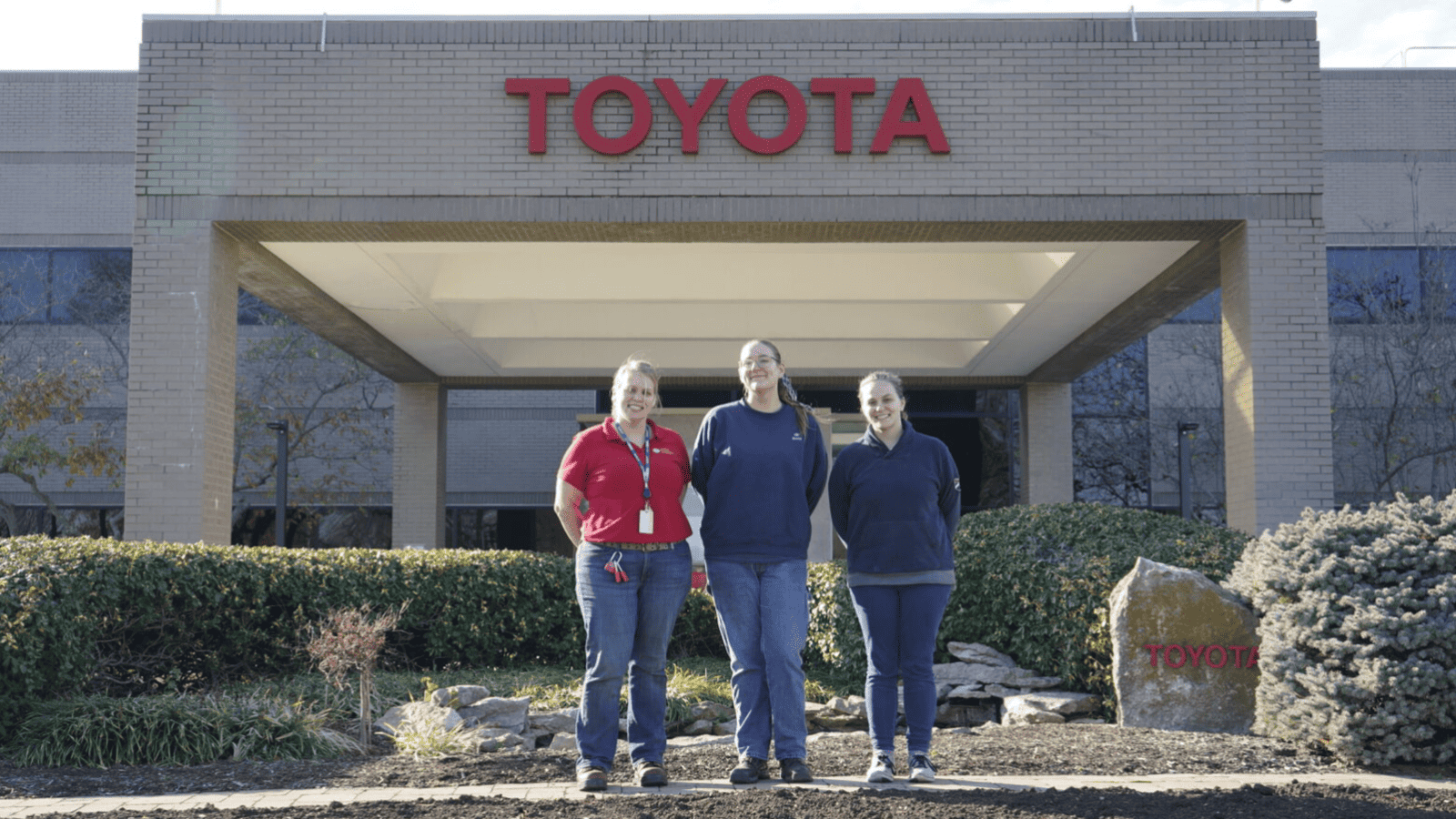
For three sisters in Kentucky, manufacturing is a family affair.
Emily Bastin, Heather Craven and Hannah Geneve are all working in maintenance roles supporting various shops at Toyota Motor Manufacturing Kentucky. Growing up, they had disparate interests—while Emily had taken robotics classes in middle school and Heather had always enjoyed working with her hands, Hannah switched to manufacturing only after working in customer service. Today, all three of them are building careers in manufacturing together.
How they got here: Emily, Heather and Hannah found their way into manufacturing through FAME—an initiative for current and aspiring manufacturing workers that was founded by Toyota in 2010 and is operated today by the Manufacturing Institute, the NAM’s workforce development and education affiliate.
- The FAME Advanced Manufacturing Technician program offers on-the-job training and classroom education that combine technical training with professional practices and lean learnings to create world-class technicians. The two-year AMT program leads to an associate degree and the FAME certificate.
- “They came to my school—the AMT program—and I was like, you know, let’s give this a shot,” said Emily. “I didn’t realize I would have that kind of potential. This was cool stuff.”
The family business: Emily was the first of the three sisters to graduate from FAME, and she has been helping her sisters as they work their way through the program. Both Hannah and Heather are enrolled in FAME while working at Toyota, and they expect to graduate in May 2025.
- “We’re all working in the same plant, and if they need anything from me, I’m there to be supportive,” said Emily.
- “With schoolwork, I try to help Heather, and she tries to help me,” said Hannah. “We all help where we can.”
- “It’s nice to have that sister love to lean on,” said Heather. “They understand the frustration of school and work, and it’s been a pleasure to work with them.”
Opportunities abound: The sisters advise others who might not have considered manufacturing as a career—especially women—to give the industry a second look, emphasizing the sheer diversity of jobs on offer.
- “Working in manufacturing doesn’t necessarily mean you’re working on a factory floor,” said Hannah. “There’s an administrative side, an HR side—there’s a lot more to manufacturing than people expect.”
- “I do see us being examples for women who might not normally see themselves in the field,” said Heather. “You want to see women come in and say, hey, I did it, and you can, too. It’s nice to see yourself reflected back.”
The community: It’s not just their family ties that keep the sisters in manufacturing. All three sisters have high praise for their fellow students and colleagues, and for the supportive culture they’ve encountered at Toyota.
- “The mentorship I got helped me gain my confidence while I was learning,” said Emily. “And even now, the teamwork that goes into everything, every day—it’s been a nice surprise.”
- “Everyone has been super nice, super helpful and super welcoming,” said Hannah. “When you start out, it can seem intimidating, but everyone’s willing to help you out. They really want you to succeed.”
The last word: “It’s nice to feel like you’re a part of that network—that family,” said Heather.
The MI’s 35×30 campaign aims to increase the share of women in manufacturing to 35% by 2030 and spotlights outstanding women in the industry like these sisters. To learn more about Women MAKE America and explore its many opportunities, including its new mentorship program, go here.
The Federation for Advanced Manufacturing Education provides global-best workforce development through strong technical training, integration of manufacturing core competencies, intensive professional practices and intentional hands-on experience to build the future of the modern manufacturing industry. Learn more here.
How One Manufacturer Is Building a Local Talent Pipeline
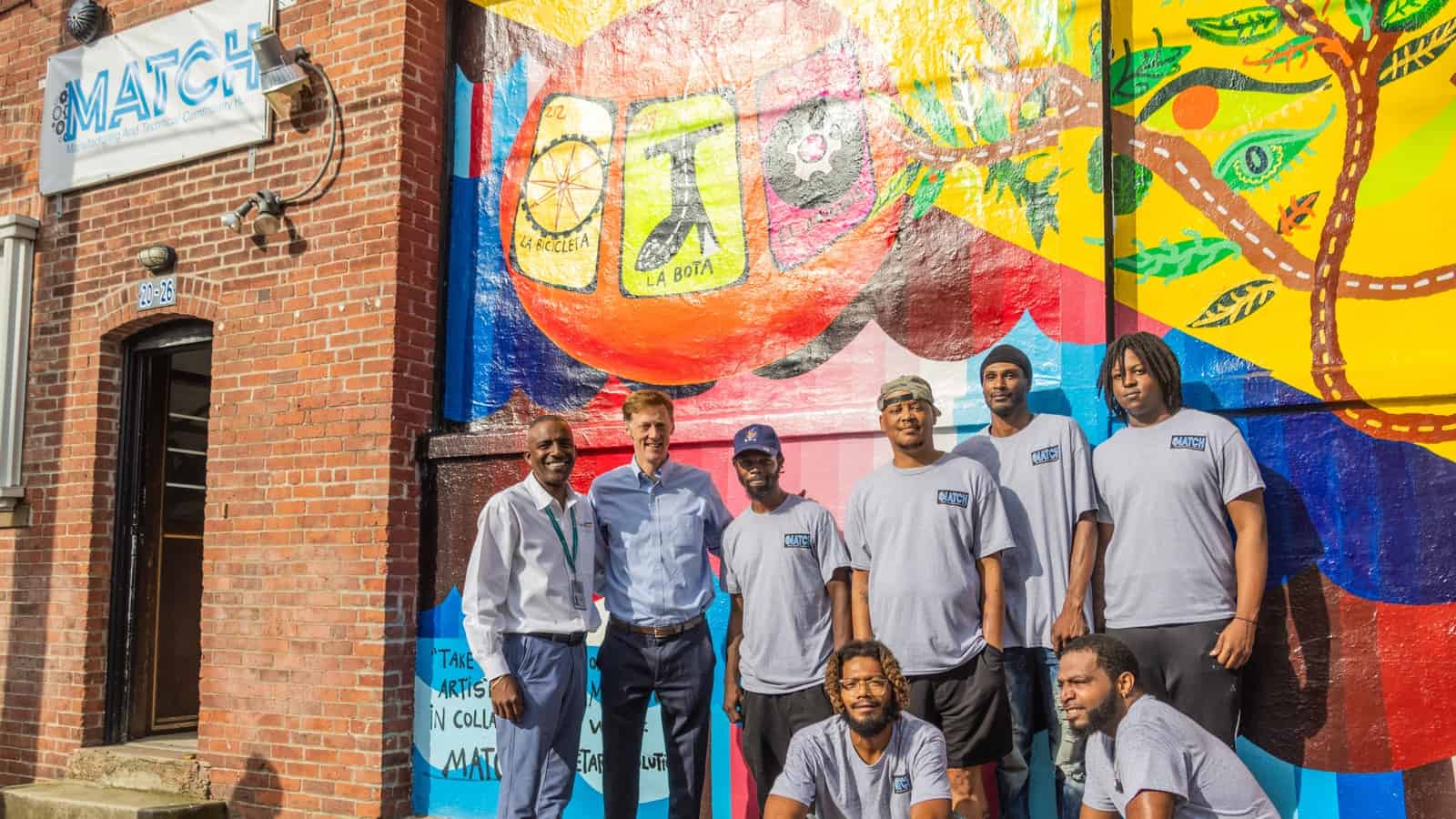
The president of Connecticut-based outdoor lighting manufacturer Penn Globe recently oversaw the launch of a long-awaited passion project: the Manufacturing and Technical Community Hub, or MATCH, a New Haven, Connecticut–area nonprofit contract manufacturing organization and training program designed to fill job openings in the sector.
Seeing a need: “I am a manufacturer, and one of the things I saw missing from the various workforce training programs available was the manufacturers themselves,” LaFemina said. “They weren’t reaching [the participants] in these training programs. So I was a bit frustrated, but that frustration was good … because it led us to create a program with manufacturers training people for actual manufacturing jobs.”
- In 2021, LaFemina and MATCH co-founder Lindy Lee Gold, senior regional manager of the Connecticut Department of Economic and Community Development, secured funding from partners including Lee’s agency, the city of New Haven, the Connecticut Department of Labor and numerous nonprofits.
- This past June, after LaFemina—now MATCH board chair—and the rest of the organization’s board of directors signed a lease on a building, MATCH was born.
How it works: MATCH begins with a two-week, earn-as-you-learn program, offered in both English and Spanish.
- The organization offers training in everything from basic welding to CNC machining, allowing participants to choose the type of manufacturing that interests them most.
- Then, depending on the complexity of their chosen specialty, they may spend up to six additional weeks in paid, on-the-job training before being placed in jobs with local manufacturers.
Meeting the moment: Unlike job-training offerings that expect a certain level of familiarity with an industry, MATCH starts from scratch.
- “Some places say, ‘Let’s test you on something you know nothing about,’” LaFemina told us. “We want to meet the moment. … We’re asking you to come in, give us two weeks and we will pay you minimum wage for the time that you’re here learning.”
- “We’ll figure out what you like and what you’re good at, and as long as we have the workload to make things, you’ll have a job,” she continued.
Being accessible: MATCH also prides itself on seeking out potential employees, instead of waiting to be found.
- “We wanted a building in a specific neighborhood in New Haven,” LaFemina said. “It’s where the majority of the social agencies are, the immigration services, the reentry services. I’d been hearing for two years about how people have [training] programs but couldn’t get participants because [the program locations] were difficult to get to. This one isn’t.”
Family friendly: One of MATCH’s main goals is to reach parents, many of them women, who have left the workforce due to difficulty securing child care. The program’s core hours are 9:00 a.m. to 2:00 p.m., Monday through Friday, in sync with those of most schools.
- MATCH partners are already considering using the program’s New Haven facility as a training site for day care providers, to help alleviate the shortage of workers in that sector.
- In addition, the program’s first cohort of students came from the New Haven Healthy Start’s Fatherhood Involvement project, one of several local initiatives with which the organization has ongoing relationships.
What’s next: MATCH is on track to be financially self-sustaining in three to five years—and LaFemina predicts big growth after that.
- “I see multiple MATCHes down the road,” she said. “There’s already a call for more. My biggest goal is in a few years all of us older people, who leveraged our connections to make this happen, will turn it over to a younger group that will turn it into something even better than it already is.”
Creators Wanted Tour Culminates at Pumpkin Show

The Creators Wanted campaign—an initiative of the NAM and the Manufacturing Institute aimed at driving excitement about modern manufacturing careers—is concluding the wildly successful run of its immersive experience with a significant finale at the Circleville Pumpkin Show, one of the largest annual festivals in the country.
By the numbers: Since it began last year, Creators Wanted has created quite a stir.
- More than 13,000 students, educators and community leaders have engaged with the tour directly.
- Online, 1.5 million students and mentors have signed up to explore modern manufacturing careers.
- A whopping 84% of tour participants now view manufacturing careers more positively.
- Positive industry perception among parents has jumped nationwide from 27% to 40%, thanks in part to the tour and associated MI programs.
Watch a recap of the tour featuring the voices of students, educators and parents who share their perspective on the tour’s impact.
Next week: From Oct. 17–21, half a million attendees, including families and students, will have a chance to experience the tour’s immersive setup, a featured event at this year’s show.
- Manufacturing team members from the Honda and LG Energy Solution joint venture (the tour stop’s sponsor) will be present, offering insights into modern manufacturing careers.
- The Creators Wanted online training program and jobs resource will be showcased, and the tour will engage with local schools, particularly STEM students, amplifying the opportunities in manufacturing.
The big picture: With industries vying for the best talent amid continued labor challenges, initiatives like the Creators Wanted Tour play an essential role in reshaping public perceptions and attracting the next generation into manufacturing over other potential career options.
What’s next: “Now, we know our work is far from over, and so our work goes on with the MI, building on this momentum, along with Creators Wanted digital resources, ” said NAM President and CEO Jay Timmons, who also serves as chairman of the board of the MI.
Warehouses Turn to Flex Workers

Logistics companies are increasingly using “flexible workers” to fill open positions, according to The Wall Street Journal (subscription).
What’s going on: More operators, competing with other employers that allow workers to make their own hours, are offering scheduling and shift flexibility.
- They’re using specialized software to do it, one source told the Journal, adding that the practice is one of the ways logistics firms are hiring in the runup to the holiday season.
Why it’s important: This “flexibility in a field known for rigid schedules and grueling workloads is a sign that the practices of app-driven operators are seeping into more traditional workplaces, particularly in a tight market for blue-collar workers.”
Vetted and ready: Not just anyone can fill a warehouse-worker slot, in part “because industrial jobs require specific training and expertise, logistics experts say.”
- To ensure those they bring on are qualified, logistics companies have begun using warehouse-tailored gig-worker apps, in which “[w]orkers set their availability in advance … and go through a background screening process” with the app company.
- Logistics companies often use traditional staffing agencies “particularly for the peak holiday season. But some are looking to fill jobs when they need people in a more targeted way, such as Monday mornings to catch up with e-commerce orders that came in over the weekend.”
A supplement, not replacement: Even companies that plan to stick with full-time employees are seeking ways to use the gig model to their advantage.
- “PepsiCo is testing a platform that allows warehouse workers to easily swap shifts from their smartphones, among other functions, said John Phillips, senior vice president of customer supply chain and global go-to-market.”
Layoffs at Automakers, Suppliers Mount as UAW Strike Continues

The “Big Three” carmakers are being forced to keep laying off workers as the United Auto Workers union continues its strike, according to CBS News.
What’s going on: To date since the strike began, General Motors, Ford and Stellantis have had to lay off a total of 4,835 employees.
- “While we are doing what we can to avoid layoffs, we have no choice but to reduce production of parts that would be destined for a plant that is on strike,” Ford Vice President for Americas Manufacturing and Labor Affairs Bryce Currie said in a statement this week, CBS reports. “Strike-related layoffs are an unfortunate result of the UAW’s strategy.”
- In addition, many auto suppliers have suspended the employment of hundreds of workers because of the strike.
Why it’s important: Economic losses to the auto industry through the first three weeks of the strike totaled approximately $5.5 billion, Michigan-based economic consultancy Anderson Economic Group estimates.
- That figure includes $2.68 billion in lost revenue for the carmakers, $579 million in direct wages for workers, supplier losses of $1.6 billion and dealer and customer losses of $1.26 billion.
The NAM’s take: “The strike is causing tremendous economic harm throughout the economy,” said NAM Vice President of Economic Policy Brandon Farris. “It isn’t just the automakers, but every employee that has been laid off and many of the small and medium manufacturers that supply them.”
- “Many of those manufacturers may never recover,” he continued. “The NAM strongly urges a quick resolution. The longer the strike lasts, the harder it will be to undo the drastic economic harm caused to employees and manufacturers.”
New Manufacturing Institute Study: How Firms would Invest a Marginal Dollar with their Company
Washington, D.C. – The Manufacturing Institute, the workforce development and education affiliate of the National Association of Manufacturers, in partnership with Cognizant, released a study that examined the different approaches manufacturers take in making investment decisions.
“As manufacturers continue to evolve, the nature of work and skills must adapt to meet the needs of the changing industry. Manufacturing leaders must prioritize investments to best position their companies in a competitive marketplace and set themselves up for success over the long term,” said NAM Chief Economic and Director for the Center of Manufacturing Research Chad Moutray. “Three investment priorities emerged across manufacturer size and industry: increasing throughput and lowering costs where possible, creating new opportunities for growth, and building a stronger, more resilient workforce. Nearly all the companies we interviewed emphasized the importance of investing in their workforce.”
The study consisted of an online survey and in-depth interviews of manufacturing leaders from June to August 2023.
The following are highlights of the report:
- When asked about their top priorities for current dollars, nearly 74% of manufacturers reported building a robust and trained workforce as a key area for investment, which fits in with the larger macroeconomic conditions of the tight labor market and shortage of available workers.
- When business leaders were asked how they would spend a marginal $1 million, 61.5% would invest in new equipment. These findings point toward a desire to make smart investments that will transform operations and the production process, while also ensuring that the workforce can adapt to such changes.
- Additional areas of focus for marginal dollar investment included investing in improved processes and operations (60.2%), optimizing existing equipment (53.4%), investing in new equipment (51.7%), investing in new technologies (46.6%) and research and development (44.9%).
- When considering their future growth strategies, manufacturers identified a stronger domestic economy for growing sales (69.5%), increased efficiencies in the production process (67.8%) and maintaining a robust and trained workforce (67.0%) as the most significant factors in contributing to expansion.
Key Takeaway:
From survey data and interviews, three investment priorities emerged across manufacturer size and industry:
- Increasing throughput and lowering costs where possible
- Creating new opportunities for growth
- Building a stronger, more resilient workforce
-The MI-
The Manufacturing Institute builds a resilient manufacturing workforce prepared for the challenges and opportunities of the future. Through implementing groundbreaking programs, convening industry leaders and conducting innovative research, the MI furthers individual opportunity, community prosperity and a more competitive manufacturing industry. As the 501(c)3 nonprofit workforce development and education affiliate of the National Association of Manufacturers, the MI is a trusted adviser to manufacturers, equipping them with solutions to address the toughest workforce issues.
733 10th St. NW, Suite 700 • Washington, DC 20001 • (202) 637-3000
UAW Strike Means Supplier Layoffs

As United Auto Workers President Shawn Fain prepares to give an update on labor-contract negotiations this afternoon, the UAW’s three-week-old strike at plants across the Midwest is hurting auto suppliers, according to The Washington Post (subscription).
What’s going on: “More than 3,000 supplier employees have been affected so far, a Washington Post tally shows, while an industry association says nearly 30 percent of its supplier members have resorted to layoffs.”
- More than 60% of suppliers said they expected to begin layoffs this month. Others say these cuts could “broaden over time” if the strike continues
- The strike has reverberated beyond the automotive sector, too. U.S. Steel recently announced 300 temporary layoffs after it was forced to idle an Illinois furnace because of the walkouts.
Why it’s important: “The [strike’s] fallout shows the outsize role the auto industry plays in the U.S. economy, to which it contributes about 3 percent of gross domestic product.”
- What’s more, the widespread shuttering of smaller auto suppliers—which number in the thousands and are often the main source of employment in the areas where they operate—would make it harder for General Motors, Ford and Stellantis to resume normal operations after the strike.
Manufacturers say: “The longer the strike, the more likely thousands of citizens across Michigan will face layoffs, and not just UAW members,” John Walsh, president and CEO of the Michigan Manufacturers Association (an NAM state partner), wrote in The Detroit News (subscription).
- “Layoffs, in turn, will affect restaurants, stores and local businesses. The economic impact will be felt throughout our families and our communities.”
NAM, Rep. Stauber Talk R&D, Workforce
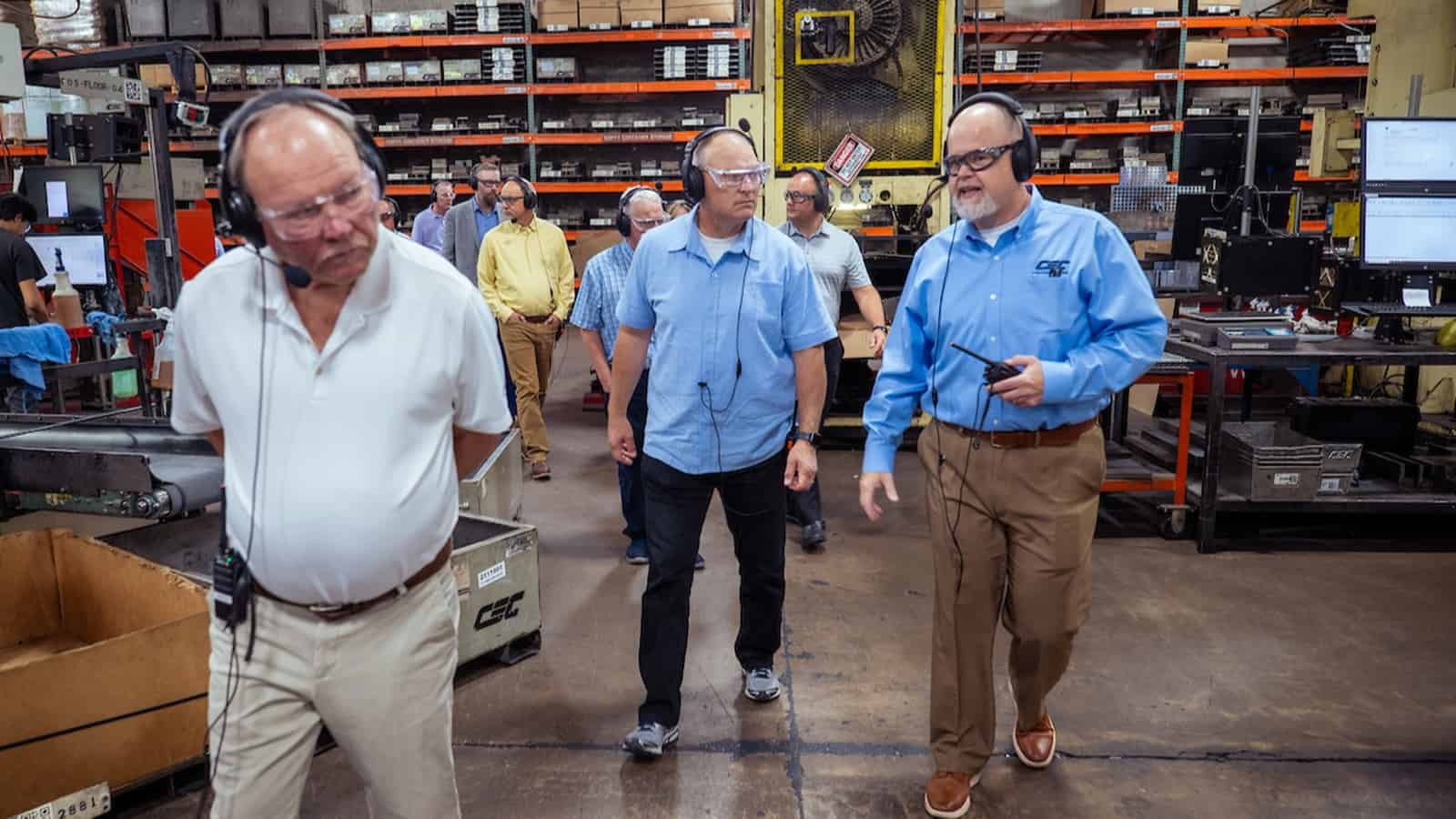
Permanent restoration of R&D expensing is a top priority for manufacturers in Minnesota and the U.S. in general. That’s why Rep. Pete Stauber (R-MN) plans to sign onto the American Innovation and R&D Competitiveness Act as a cosponsor, he recently told the NAM.
What’s going on: Rep. Stauber discussed the importance of competitive R&D tax policy, along with the regulatory onslaught targeting manufacturers and the need for permitting reform, during a recent NAM-organized facility tour of Clow Stamping Co. in Merrifield, Minnesota.
- “Full expensing for R&D costs in the year in which they are incurred is essential for innovation and competition,” Rep. Stauber told the group, which included Pequot Tool & Manufacturing CEO Karlo Goerges in addition to NAM representatives and Clow Stamping leadership. “It’s imperative that it be reinstated as soon as possible.”
- The American Innovation and R&D Competitiveness Act would restore immediate R&D expensing permanently for small businesses.
- “Full R&D expensing was instrumental in our growth until the law changed last year,” said Clow Stamping owner Reg Clow. “It’s definitely having an impact on us. Our expenses have gone way up.”
Workforce woes: Clow is nearing the end of a $20 million facility expansion that will add 107,000 square feet of floor space and at least 60 jobs—but finding enough workers to fill those jobs won’t be easy.
- By implementing automation in its shipping and receiving departments, the company will be able to both increase its shipping output without additional workers and channel its current hiring efforts toward filling open positions with the production departments, Clow said.
- This is a short-term solution, however, and manufacturers like Clow Stamping need policymakers’ help to ensure the industry has enough skilled workers for the decades to come.
- During the facility visit, the group discussed the importance of educating younger generations about the many opportunities available in manufacturing, via initiatives like Creators Wanted. This award-winning perception campaign undertaken by the NAM and its 501(c)3 workforce development and education affiliate, the Manufacturing Institute, aims to recruit 600,000 new manufacturing workers by 2025.
The last word: “Manufacturers account for more than 55% of all private-sector R&D spending in the United States,” said NAM Managing Vice President of Policy Chris Netram.
- “Policies that encourage this innovation will allow the industry to continue to drive our economy forward. The NAM thanks Rep. Stauber for his support of the American Innovation and R&D Competitiveness Act and calls on Congress to swiftly pass this bill.”
Creators Wanted and Union Pacific Dazzle the Twin Cities
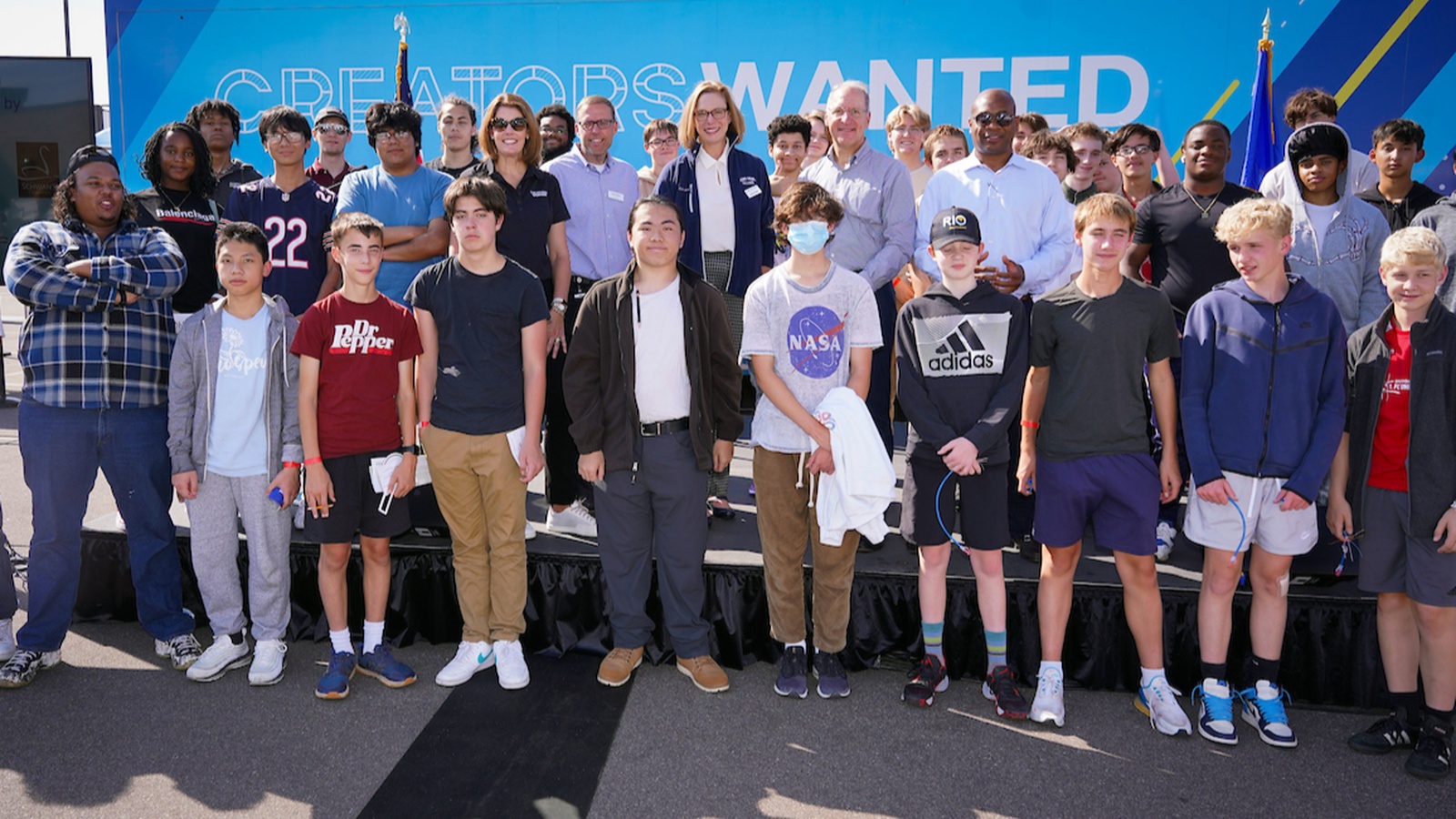
Last week, Saint Paul College in St. Paul, Minnesota, which boasts a student body that is 65% people of color, became the 19th stop of 20 for the Creators Wanted Tour, a joint project of the NAM and the Manufacturing Institute, the workforce development and education affiliate of the NAM.
Over three days, with Union Pacific as the lead sponsor, the stop drew more than 600 visitors, from students to educators. Meanwhile, 42,000 online signups in Minnesota helped the campaign surpass 1.5 million nationwide from students and career mentors interested in modern manufacturing careers.
Twin Cities kickoff: Union Pacific Executive Vice President of Marketing and Sales Kenny Rocker gave the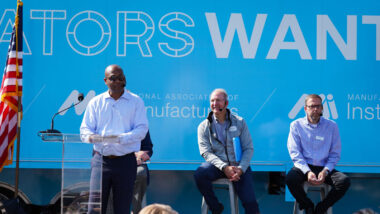 keynote address at the kickoff event, emphasizing the reward of manufacturing careers. He was joined by MI President and Executive Director Carolyn Lee, Saint Paul College President Dr. Dee Dee Peaslee, Minnesota Chamber of Commerce President and CEO Doug Loon and Trane Technologies Vice President of Product Management Dave Molin.
keynote address at the kickoff event, emphasizing the reward of manufacturing careers. He was joined by MI President and Executive Director Carolyn Lee, Saint Paul College President Dr. Dee Dee Peaslee, Minnesota Chamber of Commerce President and CEO Doug Loon and Trane Technologies Vice President of Product Management Dave Molin.
- “When I talk about opportunities, I’m talking about really good-paying jobs … At Union Pacific, we’re talking jobs that are … averaging over $100,000 a year, and that’s without benefits, and so you just really have an opportunity to make an impact from that perspective,” said Rocker.
- “At Trane Technologies, our vision is to boldly challenge what’s possible for a sustainable world,” added Molin. “It is the engine of our company, and we live it every day. And to do that, we need bright minds and the best minds in the world. We need diverse thinkers, we need creators, and our doors are open to everyone.”
- Notably, leaders from key government business and workforce partner organizations attended the kickoff, including the Minnesota State Advanced Manufacturing Center of Excellence, Minnesota Black Chamber of Commerce, Minnesota Parent Union and St. Paul Area Chamber, representatives from the offices of U.S. Reps. Brad Finstad (R-MN-1), Angie Craig (D-MN-2), Dean Phillips (D-MN-3), Betty McCollum (D-MN-4) and Michelle Fischbach (R-MN-7), Mayor of South St. Paul Jimmy Francis and State Reps. Jon Koznick (R), Emma Greenman (D) and Samantha Sencer-Mura (D).
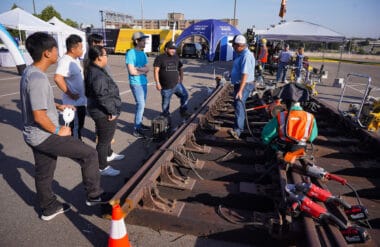
Experience and exploration: Students delved deep into immersive activities, from solving manufacturing-related puzzles in the Creators Wanted mobile experience to virtually navigating a locomotive through Union Pacific’s simulators. Equally captivating was the sight of the actual railroad track, which was complemented by insightful career anecdotes from Union Pacific professionals.
- Eighty-seven percent of students surveyed reported a significantly improved view of modern manufacturing careers after completing the immersive experience.
Live Q&A sessions: The stop also offered structured opportunities for students to learn about manufacturing organizations’ support for the next generation of talent, along with the importance of mentorship and personal development in shaping successful careers.
- The first session, featuring two Union Pacific senior managers—Amy Bang, Sr. manager of diversity and inclusion, and Ken Kuwamura, Jr., manager of talent acquisition—and Saint Paul College instructors, zeroed in on the crucial roles of mentorship, diversity and passion in career selection.
- The second session, with Jake Yernberg, automotive instructor, Saint Paul College; Caitlin Bundy, manager of corporate sustainability, Union Pacific; and Preeti Subramanian, senior product manager, Trane Technologies, accentuated the pivotal role of manufacturing in tackling global challenges. Panelists pointed out the advantages of the manufacturing sector, citing competitive pay and the sector’s potential in addressing global issues, such as sustainability and climate change.
Interactive Learning: Everfi®, Ecolab and Schwan’s joined Union Pacific in bringing in representatives to give students career advice—and offer activities to spark their curiosity.
- Everfi® showcased a new digital education program, “Future Creators,” co-developed with the MI and Union Pacific, to give middle and high school students a peek into STEM careers.
- Saint Paul College also took students on a tour of its robust Trades and Technical Education program.
Beyond the Tour: The Twin Cities event is a part of Union Pacific’s overarching “Careers on Track” initiative, which aims to inspire more women and youth to pursue modern industrial careers, and the Creators Wanted campaign’s sustained drive to enhance perceptions of manufacturing careers in the United States and empower more people to create the future.
The last word: “I want all of you out here, the students, to have an opportunity to go out there and win and compete and further your careers and do well in life,” said Rocker, echoing a theme the Creators Wanted Tour has promoted since its inception: manufacturers and manufacturing care about students and their future.
Next up: The pioneering Creators Wanted Tour concludes next month, Oct. 17–21, at the Circleville Pumpkin Show in Circleville, Ohio.
UAW Sets New Strike Deadline

The United Autoworkers union set a new strike deadline late last night, according to The Street.
What’s going on: In a video post on X, “UAW president Shawn Fain said [the union] would unveil more strike targets, with more union members participating, by noon eastern time Friday failing significant progress in talks with Ford, General Motors and Chrysler-owned Stellantis.”
- After negotiations for a new four-year labor contract failed late last Thursday, the UAW—which represents almost 150,000 U.S. autoworkers—ordered a walkout from vehicle plants belonging to the “Big Three” carmakers in Michigan, Missouri and Ohio.
- About 12,700 workers are now picketing assembly lines throughout the Midwest.
- Each of the vehicle manufacturers has put forth offers in recent days, and each has been rejected by the union, the demands of which include a sizable wage raise and a 32-hour workweek at 40-hour-a week pay.
Why it’s important: A 10-day strike of 143,000 UAW members against the three vehicle manufacturers could mean an economic loss of $5.617 billion, according to a recent report by Michigan-based consultancy Anderson Economic Group.
- A protracted strike this year would put “the state of Michigan and parts of the Midwest … into a recession,” Anderson Group CEO Patrick Anderson told the news outlet.
Our take: “ The economic harm produced by a strike goes well beyond GM, Ford and Stellantis,” said NAM Vice President of Domestic Policy Brandon Farris.
- “Numerous small and medium-size manufactures are already feeling the effects. The NAM encourages a swift resolution. Let’s get everyone back to work building products that our country relies on.”